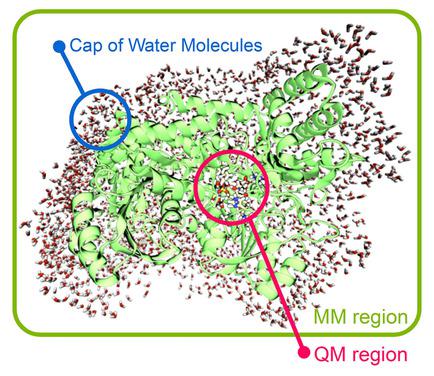当前位置:
X-MOL 学术
›
Isr. J. Chem.
›
论文详情
Our official English website, www.x-mol.net, welcomes your
feedback! (Note: you will need to create a separate account there.)
Modelling Enzymatic Mechanisms with QM/MM Approaches: Current Status and Future Challenges
Israel Journal of Chemistry ( IF 2.3 ) Pub Date : 2020-04-30 , DOI: 10.1002/ijch.202000014 Rita P. Magalhães 1 , Henriques S. Fernandes 1 , Sérgio F. Sousa 1
Israel Journal of Chemistry ( IF 2.3 ) Pub Date : 2020-04-30 , DOI: 10.1002/ijch.202000014 Rita P. Magalhães 1 , Henriques S. Fernandes 1 , Sérgio F. Sousa 1
Affiliation

|
Quantum mechanics/molecular mechanics (QM/MM) methods are presently a well‐established alternative for the study of enzymatic reaction mechanisms. They enable the description of a small part of the enzyme, where reactions take place through QM, while the majority of the thousands of atoms that comprise these biomolecules are handled through MM. While different “flavors” and variations in the QM/MM field exist, this review will focus more on the application of the ONIOM methodology, presenting a fresh perspective on the application of this popular method in light of the growth in computational power and level of sophistication of the different methodologies that it can combine. In addition to a brief presentation of the basic principles behind these methods, this review will discuss different examples of applicability, common choices, practical considerations, and main problems involved, stemming from our experience in this field. Finally, a reflection on the future challenges for the next decade in the QM/MM modeling of enzymatic mechanisms is presented.
中文翻译:

使用QM / MM方法建模酶机制:现状和未来挑战
量子力学/分子力学(QM / MM)方法是目前研究酶促反应机理的公认方法。它们可以描述酶的一小部分,其中通过QM进行反应,而构成这些生物分子的数千个原子中的大多数通过MM处理。尽管存在不同的“风味”和QM / MM领域的变化,但本文将重点关注ONIOM方法论的应用,并鉴于计算能力和计算水平的增长,对该方法的应用提出了新的见解。可以结合使用的不同方法的复杂性。除了简要介绍这些方法背后的基本原理外,本篇评论还将讨论适用性的不同示例,常见选择,实际的考虑以及所涉及的主要问题,均源于我们在该领域的经验。最后,对未来十年在酶机制的QM / MM建模中的未来挑战进行了反思。
更新日期:2020-04-30
中文翻译:

使用QM / MM方法建模酶机制:现状和未来挑战
量子力学/分子力学(QM / MM)方法是目前研究酶促反应机理的公认方法。它们可以描述酶的一小部分,其中通过QM进行反应,而构成这些生物分子的数千个原子中的大多数通过MM处理。尽管存在不同的“风味”和QM / MM领域的变化,但本文将重点关注ONIOM方法论的应用,并鉴于计算能力和计算水平的增长,对该方法的应用提出了新的见解。可以结合使用的不同方法的复杂性。除了简要介绍这些方法背后的基本原理外,本篇评论还将讨论适用性的不同示例,常见选择,实际的考虑以及所涉及的主要问题,均源于我们在该领域的经验。最后,对未来十年在酶机制的QM / MM建模中的未来挑战进行了反思。











































 京公网安备 11010802027423号
京公网安备 11010802027423号